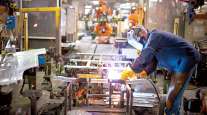Senior Reporter
Class 8 Orders Surge 212% to 43,800

[Stay on top of transportation news: Get TTNews in your inbox.]
North American Class 8 orders hit 43,800 in February, soaring 212% compared with a year earlier, ACT Research reported, citing truck makers’ preliminary data. And while orders climb, the disrupted supply chain is keeping pace and casting a widening shadow over truck production.
A year ago, Class 8 orders were 14,040, according to ACT.
The orders came as the U.S. economy is strong in areas key to truck fleets’ profitability, said ACT President Kenny Vieth.

Vieth
“Consumer spending on goods, a red-hot housing market, a re-accelerating manufacturing sector, and pent-up inventories combine to provide very good visibility to near- to midterm freight trends,” said Vieth. “Contract freight rates are at record levels, as are spot rates, after seasonal adjustment. Without injecting stimulus or infrastructure into the discussion, there is a lot to like about freight, the carrier profit outlook, and by extension the commercial vehicle demand landscape.”
ACT sees strong freight growth certainly in 2022 and probably even into 2023, said ACT Vice President Steve Tam. “So it looks like the industry is set up at this point for a longer than normal cycle and maybe a little bit stronger than normal peak.”
It is expecting North American Class 8 production to be 302,000 units, an increase of 40% compared with where the industry finished last year.
“We are looking at 2022 as pushing on 350,000,” Tam said. “The all-time high in 2006 was “north of 375,000.”
That volume would put 2022 as the second-best production year ever. That spot is currently held by production of almost 345,000 in 2019.
FTR pegged the preliminary net orders at 44,000, calling it the second-highest volume ever for any February.
“It can’t go on forever, but it is a very hot market now,” Don Ake, vice president of commercial vehicles at FTR, told Transport Topics.
Asked if there are any losers in this market, Ake said they were everywhere.
“I think the fleets are losers. They can’t get equipment and if they got equipment they could haul more freight.” He said the shippers were losers, too, because “they are paying terrifically high spot rates. The suppliers wish they could supply more, and they can’t.”
Class 8 Truck Orders: From @actresearch | February North America Class 8 truck orders at 43,800 units, up 4% MoM & up 212% YoY pic.twitter.com/MohUKPHh0Y — Markets Today (@marketstodays) March 3, 2021
Blame it on the pandemic-weakened supply chain.
“It’s a very difficult environment, and unfortunately when we have had these supply disruptions in the past, people could always kind of sense or had a good idea of when the end would be,” he said. “This time you have so many components impacted and the answers aren’t really clear because of, basically, the pandemic, you can’t really say when it ends.”
On top of that, the shortage situation is not unique to the trucking industry, he said. “It is impacting all domestic manufacturing to some extent.”
Even the truck makers aren’t winners in this environment, he added.
“You can’t sell what you can’t build,” Ake said.
Daimler Trucks North America CEO Roger Nielsen, who is retiring April 30, told TT winter weather almost always causes supply chain disruptions — materials on a truck stuck in the snow or the factories and plants aren’t actually operating because they lack the power.
“Right now, a longer term problem, we don’t have a road map to get completely out of yet is with the shortages in semiconductors, all the way down to the wafer level,” he said. “And believe me, we don’t help plan a supply chain down to that level. Definitely now we are in competition with every other consumer of silicon wafers to make sure we get our fair share moved through our value chain up to our Tier 1s.”

Fleets are investing in tech-based safety tools that inform and forewarn potential risk. But how do they condition and prepare drivers to respond to safety alerts? Find out as the RoadSigns Team speaks with Tom DiSalvi, VP of safety at Schneider National, and Charlie Mohn, director of product innovation at Drivewyze. Hear a snippet, above, and get the full program by going to RoadSigns.TTNews.com.
He added: “So far we haven’t had any stoppages of deliveries because of microprocessor shortages, but I’ll tell you that takes a significant portion of our supply chain professionals’ attention.”
All this is happening as, since June, he said, the industry has seen “rolling shortages across nearly every supplier, who will shut down all of a sudden because it has a COVID-19 outbreak or the Tier 2, Tier 3 suppliers have an outbreak.”
Ake said he doesn’t anticipate the supply chain pressures to let up all year.
Meanwhile, one large carrier, for example, is ready with a big investment for new trucks.
“Our guidance for full-year net [capital expenditure] is approximately $425 million and a key theme of the 2021 capital plan is our investment in tractors,” Schneider Chief Financial Officer Stephen Bruffett said during a recent earnings call. “In addition to our standard replacement cadence, we’ll be investing to move the average fleet age even lower.”
Schneider’s target is to get 24 months, he said. “We’re just over 30 months on average now, so we expect to improve that by the time we get through this investment program that will run through this year and into part of 2022.”
Schneider ranks No. 5 on the Transport Topics Top 100 list of the largest for-hire carriers in North America.
Want more news? Listen to today's daily briefing below or go here for more info:




